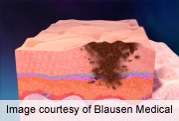Nonmelanoma skin cancers commonly occur after pancreas transplantation, particularly in those who have a history of skin cancer, according to a study published in the October issue of the Journal of the American Academy of Dermatology.
(HealthDay)—Nonmelanoma skin cancers (NMSCs) commonly occur after pancreas transplantation (PT), particularly in those who have a history of skin cancer, according to a study published in the October issue of the Journal of the American Academy of Dermatology.
Joshua P. Spanogle, M.D., of the Mayo Clinic in Rochester, Minn., and colleagues conducted a retrospective study involving 216 patients who had received allogeneic PT. Recipients were assessed at two, five, and 10 years after transplantation to evaluate the incidence, tumor burden, and risk factors for skin cancer.
The researchers found that the cumulative incidence of any skin cancer was 4.7 percent at two years post-transplantation; 12.7 percent at five years; and 19.6 percent at 10 years. The cumulative incidence of squamous cell carcinoma was 2.8, 10.3, and 16.7 percent, respectively, and the cumulative incidence of basal cell carcinoma was 2.4, 7.8, and 17.4 percent, respectively. At two years, the cumulative incidence of developing a second squamous cell carcinoma or basal cell carcinoma was 56 and 36 percent, respectively. The only predictors of skin cancer were patient age and a history of skin cancer prior to transplant.
"In light of the substantively increased risk both for primary skin cancers and for subsequent NMSCs in the PT population, preventive and mitigating measures are crucial," the authors write. "Frequent evaluation of PT recipients by a health care professional trained in evaluating skin pathology is important in lessening the effect of NMSC, which is more easily treated in the early course of the disease."
More information:
Abstract
Full Text (subscription or payment may be required)
Journal information: Journal of the American Academy of Dermatology
Copyright © 2012 HealthDay. All rights reserved.




















